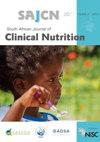Prevalence of severe acute malnutrition and its effect on under-five mortality at a regional hospital in South Africa
IF 0.8
Q4 NUTRITION & DIETETICS
引用次数: 3
Abstract
Introduction: Severe acute malnutrition (SAM) is an important global and national public health concern. It contributes to under-five mortality but is also largely a preventable disease. Objective: This study aimed to assess the prevalence of and mortality associated with SAM. Design: A retrospective review of hospital files was conducted. Setting: Dora Nginza Hospital, Eastern Cape, South Africa was the site of the study. Subjects: The study included children from 6 to 59 months of age admitted to the paediatric ward between January 1, 2018 and December 31, 2018. Children with chronic disease were excluded. Ethics approval was granted by Walter Sisulu University (053/2019). Outcome measures: Anthropometric, co-morbid and outcomes data were retrieved and analysed. Results: A total of 1 296 children were included in the study, 93 with SAM. The prevalence of SAM was 7.2%. Children with SAM had a median age of 16 months (IQR 11–25). Gender distribution was 52 (56%) females and 41 (44%) males. The inpatient mortality rate for children with SAM was 6.5%. Children with SAM were at significantly increased risk of mortality (RR 5.97, 95% CI 3.1–11.6, p-value < 0.0005). Three factors were significantly associated with mortality: nutritional oedema, sepsis, and hypokalaemia. Conclusion: The prevalence of SAM at Dora Nginza Hospital is high, and children with SAM are at significantly increased risk of mortality. Specific risk factors for mortality include sepsis, urinary tract infection, nutritional oedema and hypokalaemia. Modifiable factors associated with SAM and SAM-related mortality need to be targeted urgently to improve outcomes.南非一家地区医院严重急性营养不良的患病率及其对五岁以下儿童死亡率的影响
严重急性营养不良(SAM)是一个重要的全球和国家公共卫生问题。它造成五岁以下儿童死亡,但在很大程度上也是一种可预防的疾病。目的:本研究旨在评估SAM的患病率和死亡率。设计:对医院档案进行回顾性分析。环境:研究地点为南非东开普省的Dora Nginza医院。研究对象:该研究包括2018年1月1日至2018年12月31日期间入住儿科病房的6至59个月大的儿童。排除患有慢性疾病的儿童。Walter Sisulu University(053/2019)授予伦理批准。结果测量:检索并分析人体测量、共病和结果数据。结果:共纳入1 296例儿童,其中93例为SAM。SAM的患病率为7.2%。SAM患儿的中位年龄为16个月(IQR 11-25)。性别分布为女性52例(56%),男性41例(44%)。急性呼吸窘迫症患儿住院死亡率为6.5%。SAM患儿死亡风险显著增加(RR 5.97, 95% CI 3.1 ~ 11.6, p值< 0.0005)。有三个因素与死亡率显著相关:营养性水肿、败血症和低钾血症。结论:在朵拉·恩吉萨医院,SAM患病率高,患儿死亡风险明显增高。死亡的具体危险因素包括败血症、尿路感染、营养性水肿和低钾血症。迫切需要针对与SAM和SAM相关死亡率相关的可改变因素,以改善结果。
本文章由计算机程序翻译,如有差异,请以英文原文为准。
求助全文
约1分钟内获得全文
求助全文
来源期刊

South African Journal of Clinical Nutrition
NUTRITION & DIETETICS-
CiteScore
2.50
自引率
9.10%
发文量
21
期刊介绍:
1.The Journal accepts articles from all basic and applied areas of dietetics and human nutrition, including clinical nutrition, community nutrition, food science, food policy, food service management, nutrition policy and public health nutrition. 2.The Journal has a broad interpretation of the field of nutrition and recognizes that there are many factors that determine nutritional status and that need to be the subject of scientific investigation and reported in the Journal. 3.The Journal seeks to serve a broad readership and to provide information that will be useful to the scientific community, the academic community, government and non-government stakeholders in the nutrition field, policy makers and industry.
 求助内容:
求助内容: 应助结果提醒方式:
应助结果提醒方式:


